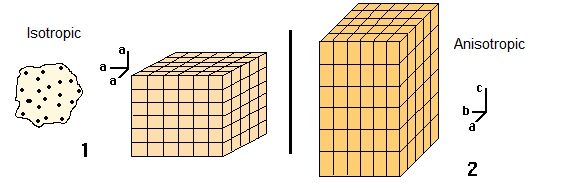Isotropic and Anisotropic
When we talk about isotropic and anisotropic magnets, we refer to whether a given magnet has a preferred direction of magnetization. In order to differentiate between them, we cannot find out just by their physical characteristics, but to know the isotropic and anisotropic behavior of a given material we have to focus on the magnetic directions of the magnet.
Isotropic magnets are magnets that have the same properties, i.e. they do not have a preferred magnetic direction pattern, thus the magnet can be magnetized in any direction. The magnetized direction must be determined prior to production. In this type of magnet, the properties are not dependent on their orientation and the particles are not causally ordered. Examples of isotropic materials are polymers, glasses, metals, liquids…
Anisotropic magnets are only magnetized in a predetermined direction, so they have a direction of magnetization with only one defined direction. The magnet has different properties depending on the direction. Neodymium, ferrite, and alnico magnets are anisotropic. A material with anisotropic behavior is wood because depending on the orientation in which it is used, it has one application or another, so it needs one magnetic direction or another.

The differences between isotropic and anisotropic behavior of material are:
Isotropic magnets have lower magnetic strength than anisotropic magnets. For example, ferrite magnets have a magnetic force of 500-800 Gauss, while anisotropic magnets have a higher force of 800-1,400 Gauss.
From the economic point of view, isotropic magnets are cheaper than anisotropic magnets.
Isotropic magnets are obtained from the granular raw material base, unlike anisotropic magnets, which are obtained from powdered raw materials.
Isotropic magnets have a size of 3-4 μm, while anisotropic magnets have a size of 0.85± 0.1 μm.
There are applications in which we can find several models, which can be anisotropic or isotropic, such as magnetic tapes and sheets.